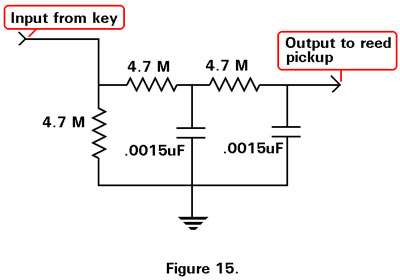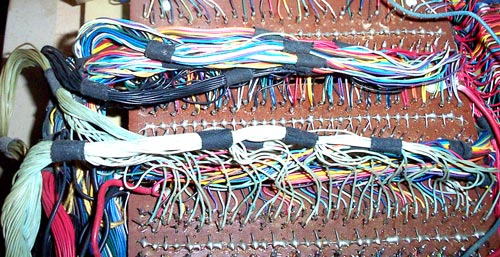Wurlitzer 4600 series
North Suburban Hammond Organ Service
When you push a key or a pedal on a Wurlitzer electrostatic instrument, you put typically +160 volts DC onto one or more of the pickups associated with the reed that generates the desired note or pitch you need at any moment. However, it is not quite that simple. If you suddenly zapped a pickup with this DC, the note would begin with a loud pop or snapping bang. In order to prevent this, it's necessary to introduce the DC voltage gradually, that is, to let it build up from zero to its full value gradually. We don't need much time for this to happen, but we can't allow it to happen instantly. As long as we make the DC voltage on a pickup build up gradually, we'll be fine.
Therefore, to make this happen, associated with each reed pickup in the instrument is a small resistor-capacitor network which schematically looks like this illustration.

Above. 160 volt DC from a key contact enters this small resistor/capacitor network. As current flows in through the 4.7 megohm resistors it gradually charges the two 0.0015 uF capacitors which means that the voltage gradually increases from zero to [typically] 160 volts. This all takes place in a few milliseconds, so that it appears to a person playing the instrument that all tones begin instantly, but in fact they do not. By allowing the DC to build up over a few milliseconds, we eliminate the sudden snap or pop that would otherwise result if the DC instantly rose to +160. If you think Hammond key clicks are bad, you would not believe what a Wurlitzer ES instrument does if you directly zap the reed pickups with +160 volts!
Likewise, and perhaps just as important if not even more important, when you let go of a key, this small network allows the DC on the reed pickup to die out gradually. The two capacitors have to discharge to ground through the three 4.7 Megohm resistors. Therefore this gradually lowers the voltage on the pickup and causes the generated audio signal to decay over about 100 milliseconds. Again, to the performer it appears as though the signal ends when you let go of a key, but in fact it has a very short sustain or natural sounding decay. In real musical instruments [non-electronic, that is] their sounds always have a slight amount of naturally occurring decay as the strings, air columns, reeds or other vibrating elements gradually, but not instantly stop vibrating. Every single electrode in these Wurlitzer ES instruments is keyed through a network identical or similar to the above.

Figure 16. This jumble of wires shows the connections to the keying networks of which one appears above in schematic form. The keyers are on the underside of the Bakelite board. Wires come in here from the contacts under the keys and pedals and also other wires (white) branch off and go to the percussion accessory.
Whenever the musician wants to introduce percussion sustain to simulate those instrumental sounds that gradually ring off like bells or various stringed instruments, he hits a switch that operates multi-contact relays that in turn switch additional resistor capacitor networks into each appropriate pickup's keying circuit to increase the decay time by adding extra capacitors that store much bigger charges and take longer to discharge.

Figure 17. Percussion relays. Unusual round relays surrounded by the extra capacitors which they switch in to add percussion sustain or fast attack.
In figure seventeen, you can see two of the four percussion accessory units. (The other two are directly below these.) In the center of each are two circular, multi-contact relays. All around the outer circumference of the percussion units are capacitors and resistors. When in use, the relay contacts close, adding these extra resistor-capacitor networks to increase the decay time for each note or pitch. There are two sustains in the instrument, one affecting the flute tones from the pickups above the front ends of the reeds, and one affecting the tones from the sheet metal pickups at the front edge of each reed, so that the two types of waves can be sustained or not independently of each other. A second circular relay also switches to the fast or percussive attack mode which makes the flute tones (only) begin percussively. This view is looking down into a 4600 series instrument with the top removed. The metal chassis in the background is the power supply for the stop action torque motors which rotate the busbars under the keys and pedals in or out of playing position.
The next thing that we need to look at regarding these instruments is their vibrato. In pipe organs, vibrato is produced by cyclically varying the instantaneous pressure of the air supplied to the pipes. You would think that this same idea would work in a Wurlitzer 4600 series instrument, but it will not. Free reeds, such as the ones used as the variable capacitors in these instruments are essentially constant frequency devices. Varying the air pressure will not make them appreciably vary their pitch, only their volume. Yes, to be technically correct, there will be a very slight frequency change if you vary the pressure, but it is an exceedingly small frequency change, and not enough to produce any sort of a decent vibrato. Therefore, the device that is so successful in pipe organs would be useless here.
The air pressure that runs the reeds remains constant. When the musician wants to have the vibrato effect, he flips the appropriate stop tabs and a special circuit in the power amplifier adds true frequency modulation to the electrical signals passing through the treble channel of the amplifier, which is the channel that handles the signals from Tenor C on up to the highest C of the instrument. On the next page, we'll see how this works.
Previous Page Page 11. next Page